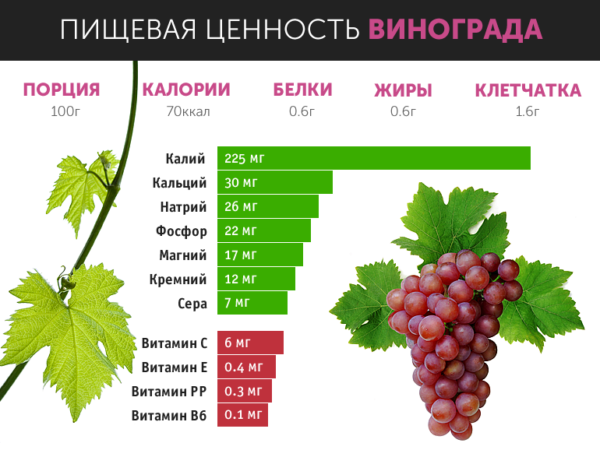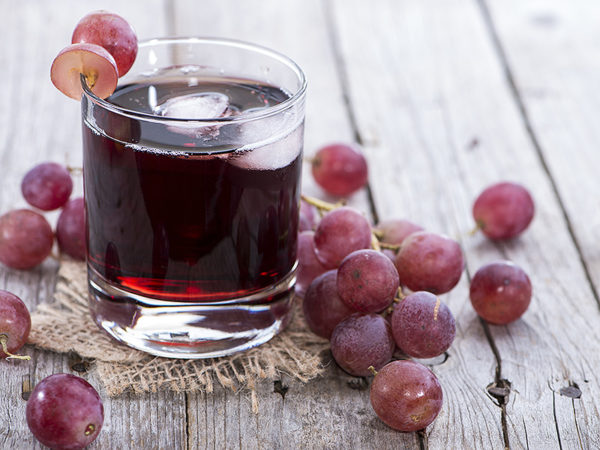A lot of us love grapes. This berry can be used both fresh and made from it wine, fruit drinks, juices, preserves, compotes. But what vitamins are contained in the berry? Can I eat it when breastfeeding? Give to children and pregnant? Why? Let's talk about its harm, benefits, and effects on the body.
Table of contents
The composition and nutritional value of grapes
Let us consider in more detail what substances, vitamins and trace elements are contained in grape berries.
Vitamin composition
Vitamin composition (in 100 g) is as follows:
- C (ascorbic acid) (6000 µg.) - helps the immune system in combating diseases and viruses, significantly slows down aging, improves the condition of blood vessels, skin cells, the nervous system, metabolism, reduces blood cholesterol, promotes the elimination of heavy metals and toxic compounds from the body;
- H (biotin, coenzyme R) (1500 mcg.) - improves the nervous system, the condition of the skin, hair, helps in the fight against diabetes, in the processing of glucose and burning fat in the body;
- E (Tocopherol) (400 mcg.) - increases the level of immunity of the body, reduces the likelihood of atherosclerosis and diseases of the cardiovascular system by 30%, helps the development of male semen, reduce the number and depth of wrinkles, improves the condition of the skin, nails, hair;
- PP (niacin, nicotinic acid) (300 µg.) - promotes the synthesis of hemoglobin, tissue growth, reduces cholesterol and the likelihood of developing diabetes, migraine, helps to balance the level of various hormones in the body, improves the functioning of the liver, pancreas;
- B6 (pyridoxine) (90 µg.) - facilitates the conversion of amino acids, fatty acids, glucose, improves cell metabolism, memory, reduces the risk of atherosclerosis, heart attack, myocardium, coronary heart disease, normalizes the level of potassium and sodium;
- B5 (pantothenic acid) (60 µg.) - reduces the level of cholesterol, the risk of cardiac arrest, normalizes the level of blood sugar, participates in the synthesis of important for the body acids, fat, protein metabolism, facilitates easier absorption of other vitamins;
- B1 (thiamine) (50 µg.) - indispensable for the work of digestion, nervous system, heart, intestines, stimulates immune defense, brain activity, improves blood circulation, is very useful for the elderly;
- B2 (riboflavin, lactoflavin, hepatoflavin, “yellow sugar”) (20 µg.) - helps reproductive function, improves eyesight, work of the heart, intestines, thyroid gland, urinary organs, promotes the growth of hair, nails, facilitates the absorption of vitamins K, B9, B6);
- A (retinol) (5 µg.) - useful for the formation of the skeleton, teeth and bones, improves the protective functions of mucous surfaces, helps in the formation of proteins, in the fight against viruses and bacteria, slows down the aging of the body;
- B9 (folic acid) (2 μg.) - it is irreplaceable in the process of production of red blood cells, normalizes its composition, slows down aging, contributes to the restoration of cells and tissues of the body after damage, normalization of carbohydrate-fat metabolism;

Useful macronutrients
In addition, the berries contain such macronutrients (in 100 g of ripe delicacy), as:
- Potassium (225,000 mcg.) - vital for the normal functioning of the cells of the body, its systems and organs, blood vessels and muscles, helps remove excess and harmful fluids from the body, regulates blood and arterial pressure, the level of potassium in the body;
- Calcium (30,000 mcg.) - participates in the formation of bone tissue, teeth, prevents the occurrence of diabetes and cancerous tumors of certain organs, supports the work of the heart, normalizes the level of sodium;
- Sodium (26,000 mcg.) - determines the proper organization of water-salt metabolism in tissues, improves the functioning of the kidneys, blood vessels, muscles, promotes the formation of gastric juice, normalizes the balance of acids and alkalis in the body;
- Phosphorus (22000 mcg.) - improves the growth of bones and teeth, cell division,energy production during digestion and assimilation of food contributes to the normalization of metabolism, the functioning of the nervous system, energy metabolism;
- Magnesium (17,000 mcg.) - promotes the growth of bones, teeth, rapid recovery of the body after stress, disease, absorption of other trace elements in the blood, removes radionuclides, normalizes the heart and blood sugar levels;
- Sulfur (7000 mcg.) - helps the formation of bone and nervous tissue, hair, nails, cartilage, normalizes metabolism, oxygen balance, blood sugar levels, facilitates the assimilation of trace elements;
- Chlorine (1000 mcg.) - helps to remove salts from the body, improves digestion, the state of red blood cells, the liver, the balance of alkalis and acids in the body.

What are the trace elements contained in the berries
Also, the grapes are rich in the following trace elements (100 g of berries):
- Cobalt (2000 mcg.) - actively contributes to the normalization of the endocrine system, blood formation, intestinal microflora, improves red blood cell production in the bone marrow, the condition of hair, skin, reduces cholesterol levels, counteracts aging;
- Iron (600 mcg.) - participates in blood formation and fermentation of proteins, improves metabolism in cells, contributes to the proper functioning of the nervous system, thyroid gland, brain, heart;
- Aluminum (380 mcg.) - contributes to the renewal of bone and connective tissue, epithelium, harmonizes the work of the gastrointestinal tract, counteracts the development of osteoporosis, gastritis;
- Boron (365 mcg.) - actively promotes the development and strengthening of bone tissue and blood vessels, supports the balance of hormones, converts vitamin D in the body;
- Rubidium (100 mcg.) - stimulates the cardiovascular and nervous system, promotes the growth of blood pressure;
- Zinc (91 µg.) - improves the nervous system, reproductive function, metabolism at the cellular level, is involved in the formation of about 300 hormones and enzymes of the body;
- Manganese (90 mcg.) - contributes to cell development, proper assimilation of vitamin B1, copper and iron, is necessary for the organization of proper functioning of the thyroid gland, the central nervous system, is an active antioxidant;
- Copper (80 µg.) - participates in the processes of oxidation and reduction in cells, improves the functioning of blood vessels, endocrine system, pituitary, promotes the production of hemoglobin, collagen, gastric juice.
In 100 gberries also contain: nickel (16 µg.), silicon (12 µg.), fluorine (12 µg.), vanadium (10 µg.), iodine (8 µg.), molybdenum (3 µg.). But most of all in the berries of potassium and vitamin C.
The benefits of white and black grapes
There are about 20,000 grape varieties in the world. There are white, red, black and green varieties. What are their features?
- White appearance helps to quickly relieve fatigue., fills with energy, increases the level of iron in the blood.
- Red has an antiviral and antibacterial effect, The antioxidant effect of this fruit is 12 times higher than that of the white one.
- Dark appearance can lower blood iron levels.It is the most useful of all types of this plant. Reduces the likelihood of the formation of cancer, improves the functioning of the heart and blood vessels.
- The effect of green on the body is similar to the effect of red. Also he reduces the chance of migraine and facilitates the course of bronchial asthma.
There are seedless varieties, such as Kish-mish. They are very suitable for making raisins. For the production of wine is used in all no more than 140 grape varieties.

Benefits and harms during pregnancy
And now we can talk or not to eat grapes pregnant. During pregnancy, grapes can be consumed, but in moderation in any trimester (first, second, third). This berry is rather caloric (70 kcal. Per 100 g), has a high content of glucose and fructose, helps to improve blood clotting. It also boosts immunity, helps cleanse the liver of toxins, promotes weight gain.
Grape juice in moderation is also very useful for pregnant women. On the day, enough to write 200-250 g of juice (better - in the morning).
Overuse of grapes, especially sultry, can lead to fermentation in the stomach and bloating, which worsens the condition of the uterus. Sometimes it causes miscarriage. In the later periods it is better to abandon the use of grapes.

A berry should be excluded from the diet of a pregnant woman if:
- She has diabetes (exclude completely);
- She often experiences colitis and enterocolitis (deleted completely);
- Weight gain is too large, making it difficult to vaginate (exclude on average, late term);
- An allergic reaction to the berry (a highly allergenic product) has been reported.
The grapes are also useful for the fruit being harvested, because:
- Helps develop fetal tissues, systems, and organs;
- Reduces the risk of improper formation of the visual and nervous system of the fetus;
- Promotes the development of the correct gene set and skeleton.
Eating berries is allowed no less than a few hours before the expectant mother takes her medications. The enzyme resveratrol, which is contained in the berries, is able to break down some drugs to a state of toxicity. It is worth remembering that excessive grape eating can cause congenital allergies on the fetus and its components in the child.
Benefits for children and how many months to give
From how many months can you give a child grapes? Let's figure it out! Even the ancient Greek physician Hippocrates argued that the composition of the grapes is identical to the composition of breast milk. Grapes are often included in the diet of children as a diet, as it is rich in sugars,acids of organic origin (malic, amber, citric, oxalic). They improve the quality of the gastric juice, prevent stone formation in the kidneys, do not oxidize blood, improve the appetite and quickly restore the strength of the child.
The child should be taught to eat grapes, starting with one year old with a few berries a day. Care must be taken that he did not choke and did not inhale the small berry.
Grapes can be given to a child already a year, watching his reaction to the berry.. How much to give for one feed? The rate at this age is a few small berries per day. If after a month no reactions appear, the dose can be increased.

Is it possible to grape moms during breastfeeding (gv)
Experts have not been able to give a definite answer to this question. If a nursing mother does not have enough milk, then the berry can help its secretion (especially red and green varieties).Also, grapes are useful for depression, anemia (some varieties), insomnia. But, eating berries can contribute to the appearance of colic, exacerbation of peptic ulcer, diarrhea, exacerbation of the problem of obesity. A nurse is better not to eat the berry until the breast-fed child is 3-4 months old.
When lactating lactating it is useful to introduce grapes into your diet, starting with its juice, diluted with water in equal shares. Taking the juice on guv, it is necessary to monitor the reaction of the body of the newborn, who may experience colic, allergies. Mom is not recommended to use more than 200 g of juice per week.
In general, the value of grapes for the human body of almost any age can not be overestimated. This tasty and beautiful berry is useful for both adults and children. With some diseases and during pregnancy, it should be used with caution. Vitamins, amino acids and microelements contained in grapes are actively involved in all the major life processes of all systems and organs of a person.
